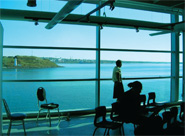
NSCAD University’s modern new Port Campus overlooking the Halifax harbour. (Rory Hyde)
Recent ratification of short-term collective agreements at NSCAD University coupled with a $2.4 million provincial bailout of the school’s deficit have brought only temporary stability to the venerable but cash-strapped Nova Scotia institution.
The province came up with the money following the release of a consultant’s report which calls the situation at the university “unsustainable,” and blames the bulk of the deficit on a decision made by the school’s former administration to proceed with construction of a waterfront campus before securing funding for the project.
The 13-page report by former deputy minister Howard Windsor calls for the bailout to hinge on the university’s agreement to investigate opportunities for collaboration with other universities, and produce a viable financial plan based on consultation with stakeholders by March 31.
Alvin Comiter, president of the Faculty Union of the Nova Scotia College of Art and Design (FUNSCAD)said it’s unlikely a plan encompassing meaningful consultation can be produced under such a tight deadline.
“The government is determined to have us fail in coming up with a new plan,” he said. “We fear it’s a set-up. We’ll fail, and they will impose a merger.”
A previous report submitted in September 2010 to the province had pointed to NSCAD as a university in crisis and called for merger with Dalhousie University.
Comiter says merging with Dalhousie would likely mean job losses and the end of many courses currently offered by NSCAD.
Daniel O’Brien, former president and vice-chancellor of New Brunswick’s St. Thomas University from 1990 to 2006, has been appointed by the province to facilitate NSCAD’s review of its curriculum and space usage, and to assist in assessing the potential for collaboration.
But Comiter says he’s been told the facilitator has no plans to meet with faculty, despite the report’s recommendation on stakeholder consultation, and its repeated assertion that NSCAD’s “brand” and its unique, studio-based curriculum deserve protection and have brought a “tradition of remarkable contributions to the arts and culture of the province, Canada, and beyond.”
The collective agreement between FUNSCAD, representing about 115 full and part-time faculty and librarians, along with 30 technicians, and the university, was ratified just prior to the mid-December release of Windsor’s report.
The 18-month agreement expires at the end of 2012, and includes concessions of a zero per cent wage increase and a one-year suspension of the faculty complement clause. However, Comiter notes that FUNSCAD gained increased health benefits for part-time instructors, who make up the majority of faculty at the school.
He said FUNSCAD will continue to push for meetings with the facilitator. At 125 years, NSCAD is the oldest independent school in Canada granting fine arts degrees.